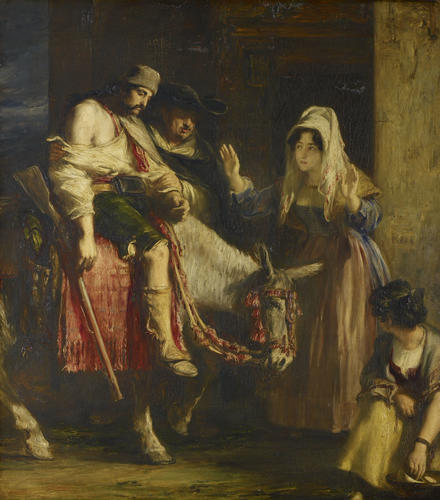The Guerilla's Return Signed and dated 1830
Oil on canvas | 95.0 x 84.5 cm (support, canvas/panel/stretcher external) | RCIN 405093
-
David Wilkie was one of the most successful painters of the Regency period and was greatly encouraged by the Regent. Born in Fife, trained in Edinburgh, Wilkie settled in London in 1805 and began regularly exhibiting at the Royal Academy small scale scenes of everyday life. At this time old master genre painting was hugely popular and expensive, as is demonstrated by the many examples of the work of Teniers and van Ostade (Adriaen and Isaac) collected at this time by George IV. Wilkie consciously emulated these low-life scenes, charging similarly high prices, but the meaning of his work shifts with the tide of British culture in the later eighteenth century towards a more celebratory (some would say sentimental) treatment of ordinary people. Teniers painted ‘peasants’; Wilkie painted the ‘the salt of the earth’. Wilkie’s royal career involved succeeding Raeburn as Limner to the King in Scotland in 1823 and Lawrence as Principal Painter in Ordinary to the King in 1830; he remained in these positions until his death, although Queen Victoria disliked his work.
In July 1825 Wilkie set off for an extended visit to the continent, taking in Italy and Spain and even a visit to Delacroix in Paris. George IV acquired six paintings (OM 1177-2, 405861, 405091-4 and 405096) from Wilkie following his return to London in 1828; this one cost 400 guineas. This group of six has considerable coherence and is characteristic of this period of art in general. This is the age during which Spain was ‘discovered’ by writers and artists as was the Italy of modern life as opposed ancient remains. This was also a period during which the priests, ceremonies and superstitions of the Catholic Church appeared in a good light, by comparison with the godless rationalism of the recently-overthrown armies of the French Revolution. Wilkie’s paintings all depict picturesque life in Italy and Spain, in which faith plays a central part; this is one of four depicting the Spanish struggle against Napoleon’s invaders during the Peninsular War (1808-14). Wilkie also changed his style during this period, taking the oil-sketches of Rubens as his model, rather than the genre paintings of Teniers, to create something grander, sketchier and more rhetorical.
This is one of a pair (OM 118-2, 405092-3) depicting the Guerilla's Departure and the Guerilla's return. Having been sent off on his mission with his confessor's blessing in scene one, the Guerilla is seen here returning, wounded, on his mule, with his left arm in a sling. He is greeted by his horrified wife, while a kneeling woman with a bowl of water is preparing to bathe his wounds. The confessor is helping him to dismount in order that he can be hidden in the cottage (or is it a church?) before it gets light. As with so many of these scenes there are curious religious overtones: in this case an ironic echo of Christ's Entry into Jerusalem.
Signed and dated: 'David Wilkie London 1830.'Provenance
Painted for George IV; added to the inventory of Carlton House dated 1819 (no 638); recorded in the 'Wilkie Bedroom' at Buckingham Palace in 1858
-
Creator(s)
Acquirer(s)
-
Medium and techniques
Oil on canvas
Measurements
95.0 x 84.5 cm (support, canvas/panel/stretcher external)
92.9 x 82.2 cm (support (etc), excluding additions)
139.8 x 129.2 x 14.8 cm (frame, external)









